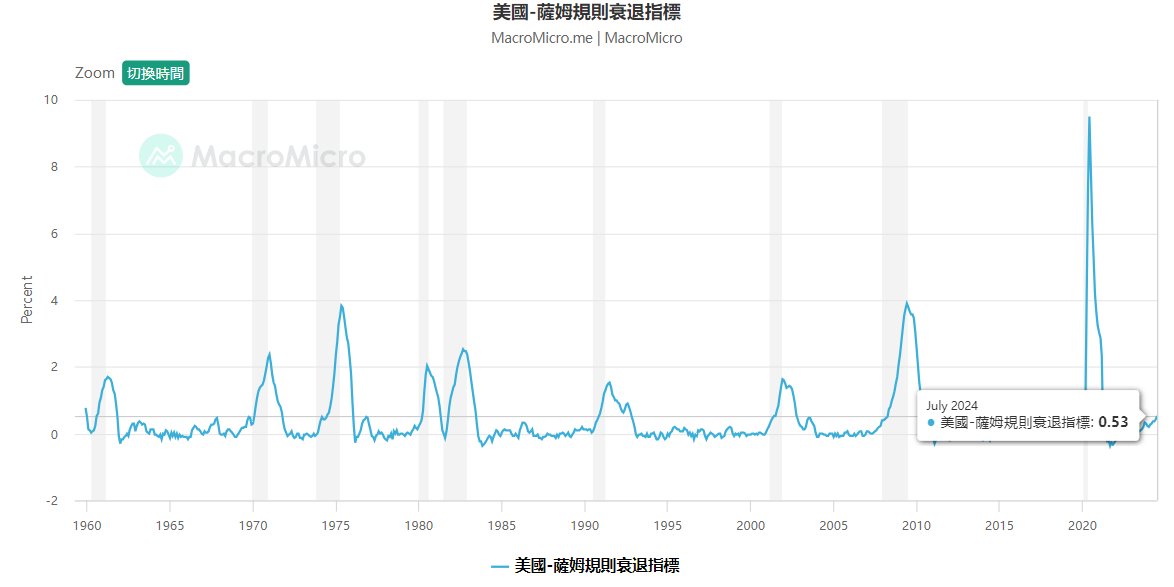The U.S. Department of Labor released the latest employment data last night (2nd), showing that the U.S. non-farm payrolls increased by only 114,000 in July, which was far lower than market expectations of 176,000 and a new low in three and a half years. At the same time, the non-farm unemployment rate also rose to 4.3% in July, higher than market expectations of 4.1%, setting a new high in three years. These data show that the U.S. job market is weak.
July non-agricultural data triggers Sam's rule
In addition, the lackluster non-farm payroll data in July immediately triggered market panic because it triggered the "Sahm Rule", which is considered a leading indicator of economic recession.
Wall Street reporter Nick Timiraos, known as the "Fed's mouthpiece," hinted as early as early July that the U.S. economy is facing the risk of recession based on the Sahm rule:
The U.S. unemployment rate rose to 4.05% in June from 3.96% in May. The data has increased by 0.22% since March.
Using Sahm's rule, the three-month average is 0.42 percentage points higher than the minimum value in the previous 12 months, and is getting closer to the 0.5 percentage point threshold.
Now the U.S. non-farm unemployment rate has climbed to 4.3% in July, and the recession indicator value of 0.53% has triggered Sam's rule (>0.5%). From a technical perspective, it can be said that the U.S. economy has fallen into a recession.

What are Sam's rules?
The Sahm rule was proposed by Federal Reserve economist Claudia Sahm. His definition is that when the three-month moving average of the U.S. unemployment rate, minus the low unemployment rate of the previous year, exceeds 0.5%, it means that the economy is going through a phase of decline.
Surprisingly, this situation has been consistent with every recession phase in the past, so this indicator is named Sam's Rule Recession Indicator.
Historical data observation, 100% triggers economic collapse
Historical data shows that Sam's rule has successfully predicted the onset of recession in every U.S. economic recession since the 1960s. The following is a list of nine recessions that Sam's rule has successfully predicted:
- 1960 Recession (triggered in August 1960): This recession lasted 10 months, starting in April 1960 and ending in February 1961, with the unemployment rate peaking at 7.1% in May 1961.
- 1970 Recession (triggered in February 1970) : This recession lasted 10 months, from December 1969 to November 1970, with the unemployment rate peaking at 6.1% in December 1970.
- 1973-1975 (triggered in March 1974) : This recession lasted for 16 months, from November 1973 to March 1975. This recession cycle was triggered by the "first oil crisis".
- 1980 Recession (triggered in April 1980) : This recession lasted from January to July 1980 because the US Federal Reserve raised interest rates to 20% in one fell swoop.
- 1982 Recession (triggered in November 1981) : This recession lasted for 16 months, from July 1981 to November 1982, and had the same causes as the 1980 recession.
- 1990 Recession (triggered in November 1990) : This recession lasted for nine months, from July 1990 to March 1991, and was triggered by the Savings and Loan Crisis and the Iraq War.
- 2001 Recession (triggered in July 2001) : This recession lasted for 8 months, from March to November 2001. The cause of the recession was the "burst of the dotcom bubble."
- The Great Recession of 2007-2009 (triggered in April 2008) : This recession lasted for 18 months, from December 2007 to June 2009, and was caused by the global bank credit crisis.
- 2020 Recession (triggered in April 2020): This recession lasted for 3 months, from February to April 2020. The cause of the recession was the Covid-19 epidemic, but the recession was caused by the Federal Reserve’s unlimited QE. The end of the policy also sows the seeds of future inflation.
In addition, from the perspective of the stock market, US stocks have experienced considerable declines in every economic recession. Among them, the recession in 2008 was the most serious, with a maximum decline of 55.2%; the recession in 1980 was the smallest, with a maximum decline of 16%.
On the other hand, we can find from the above recession events that, except for 2020, the rest of the recession cycles will last at least 8 months, and the recession cycle usually triggers Sam's rule 2 to 4 months after it starts, which means that we May already be in a recession cycle.









